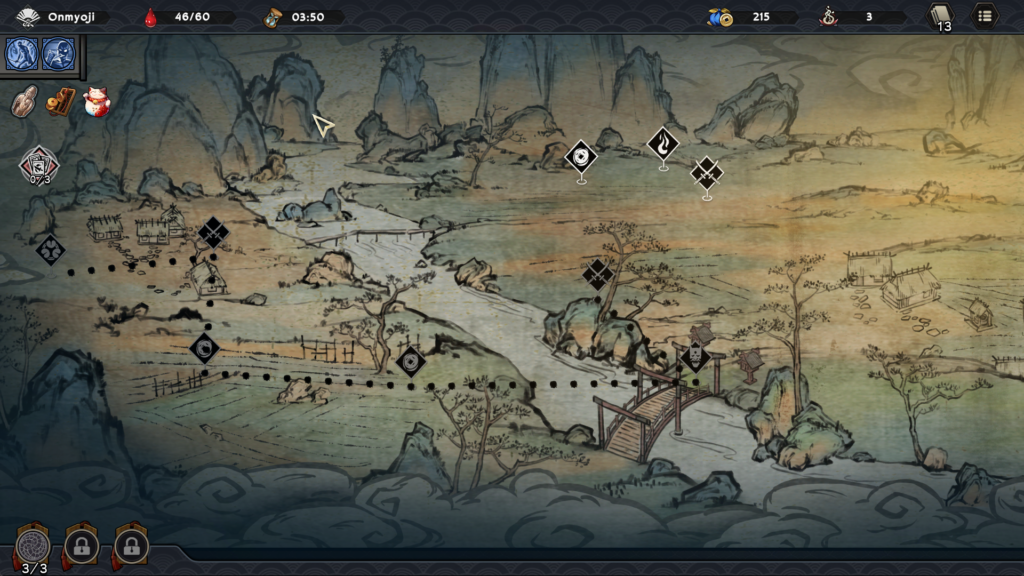Developer: Smokingbear Studio / Publisher: Thermite Games
Reviewed on the Nintendo Switch. Also available for Steam.
I can’t say no when it comes to reviewing roguelikes. The genre’s foundational aspirations of a variant loop, where the framework of different challenges stays fixed while the tools you are given and by derivation, your approach, change each and every time speaks to me. It’s a genre that is supposed to reward your ability to be flexible, that places more emphasis on understanding systems rather than memorizing specific interactions. And sure, those interactions are potent, but you’re not going to be able to rely on them constantly.
Enter Castle Morihisa, the latest of deckbuilding roguelikes. Set in a fantastical feudal Japan-inspired world, you play as one of four heroes charged with traversing the perilous lands in order to stop whatever evil lies at the heart of the titular castle. Along the way, you’ll fight giant spiders, birds, a variety of Onis, and other mythological monsters as you hone your deck and abilities in preparation to fight the final boss.
If you have played any deckbuilding roguelikes, everything I’m about to say is going to sound very familiar. You start off with a pitifully weak deck full of basic attack and block cards and one slightly better than card that serves as the foundation of your deck. After each battle, you’ll get gold and the ability to draft more potent cards to your deck. Chests contain powerful relics that offer a variety of effects. Elite fights prove to be deadly encounters but provide greater rewards if you succeed. Campfires offer a chance to rest or upgrade cards. It’s a pretty familiar framework at this point.
Castle Morihisa does have plenty of distinguishing factors though. The most prominent additional system is the “Talent grid.” Each hero comes with a circular grid of upgrades that you can spec into. The grid is randomized each and every time, although each node in the corresponding tiers is approximately equal in the advantage that it gives you, with the truly game altering ones requiring two prerequisites to even think about unlocking. Talent points are obtained naturally while progressing through the map, with events and Elite fights offering more Talents and quests that have potent effects for completing their objectives. Furthermore, at the start of each Act, you get access to a very potent hero ability that you can use once per turn in order to achieve effects ranging from massive damage, massive block, or even just execute enemies below a certain threshold. And finally, the shop is accessible at any point and retains the same stock until you refresh the shop during your run as opposed to being a potential node.
All of these elements result give Castle Morihisa a highly variable experience. Some runs, you’ll get critical relics, fights that your deck can easily handle, and the 5-cost talents you picked just happen to align with the best 7-cost talent on the grid. And then some runs, your talents will have no correlation with the cards being offered in the draft, the enemies hard counter your deck, and even with the use of hero skills, you find yourself at 1 hp and all four nodes are hallway fights that you can’t opt out of. The sheer variance of each run makes for a very uneven experience and forces you to commit a lot of your brain to a staggering number of considerations. And this isn’t helped by the enemy’s abilities being somewhat obtuse in their wording, certain abilities having weird phrasing, a cluttered UI, and controls that at times were unresponsive and unintuitive.
Mechanically, the game has several interlocking systems you have to navigate like a clockmaker. Aesthetically though, the game is very much wonderful. The art direction is fantastic, which each of the heroes having a recognizable silhouettes and the card art is expressive and makes it easy to distinguish between cards. The monster design is fantastic, and the game leverages Japanese myths to great effect with the different encounters and sprites. The soundtrack and sound design are great, and the background of each act make for a beautiful set pieces.
So now that I’ve written 600 plus words about Castle Morihisa, it is time that I bring up the fact that at the end of the day, it is a deckbuilding roguelike that currently has to coexist with the pinnacle of the genre: Slay the Spire. Castle Morihisa goes to great lengths to distinguish itself from its predecessor with the additional system and granular parsing of cards, but the end result is that the game will inevitably draw comparisons and will not quite live up to it. It is a fun game in its own right. I enjoyed the time I spent with it, can see myself returning to it, but I’m not sure it has quite captured my imagination. If you like roguelikes, you’re going to find a lot to like with Smokingbear Studio’s take on the genre. You’re going to have fun learning the different ancillary systems, and maybe the additional variances will appeal to you, but for me, the added complexity and RNG stymied it just a bit.
8.2 “Mantras” out of 10
“Want to get Black Nerd Problems updates sent directly to you? Sign up here! Follow us on Twitter, Facebook, Youtube, and Instagram!“





Show Comments